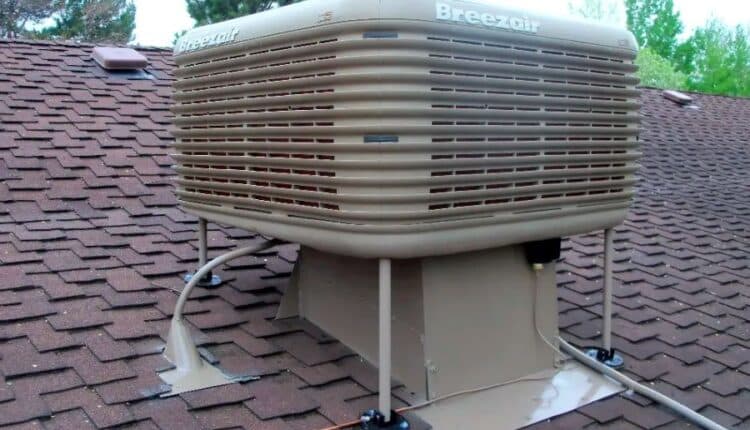Choosing the Right Evaporative Cooler: Portable vs. Whole-House Solutions
Evaporative coolers, also known as swamp coolers, provide an energy-efficient and environmentally friendly alternative to traditional air conditioning systems. They work by using water evaporation to cool air, making them particularly effective in dry climates where humidity levels are low. With several types of evaporative coolers available—ranging from portable units to whole-house systems—choosing the right one depends on various factors, including cooling capacity, space requirements, and energy efficiency. This guide will help you understand the key differences between portable and whole-house evaporative coolers, their advantages and drawbacks, and how to determine which is the best option for your needs.
How Evaporative Coolers Work
Unlike conventional air conditioners that rely on refrigerants and compressors, evaporative coolers use the natural process of water evaporation to cool the air. Warm air is drawn into the unit, passed through water-soaked cooling pads, and then circulated into the room as cooler air. Because this process adds moisture to the air, evaporative coolers work best in arid regions where humidity remains low. In humid climates, however, the effectiveness of these coolers diminishes, as excessive moisture in the air makes evaporation less efficient.
Portable Evaporative Coolers
What Are Portable Evaporative Coolers?
Portable evaporative coolers are compact, mobile units designed for cooling small to medium-sized areas. They are ideal for personal use, garages, patios, and specific indoor spaces where additional cooling is needed. Unlike whole-house units, portable coolers don’t require permanent installation and can be moved around based on cooling needs.
Key Features of Portable Evaporative Coolers
- Compact Design: Ranges from small tabletop units to larger models designed for single-room cooling.
- Ease of Use: No complex installation required—just plug in, fill the water tank, and turn it on.
- Mobility: Many units come with caster wheels, allowing users to move them to different areas as needed.
- Adjustable Settings: Includes fan speed adjustments, automatic water level indicators, and programmable timers.
- Energy Efficiency: Uses significantly less electricity than an air conditioner, making it a cost-effective option.
Pros and Cons of Portable Evaporative Coolers
Pros:
✅ Affordable compared to whole-house systems.
✅ Easy setup and no need for ductwork or permanent installation.
✅ Ideal for spot cooling in specific rooms.
✅ Low energy consumption compared to AC units.
Cons:
❌ Limited cooling range—best for small areas.
❌ Requires frequent refilling of the water tank.
❌ Less effective in extremely high temperatures or humid conditions.
❌ Not suitable for cooling large spaces.
Whole-House Evaporative Coolers
What Are Whole-House Evaporative Coolers?
Whole-house evaporative coolers are larger systems designed to cool an entire home by distributing cool air through ducts or vents. These units can either be installed on the roof, through a window, or on the side of a building, depending on the design of the home and cooling needs. Whole-house coolers are ideal for those looking for a long-term solution to cooling multiple rooms efficiently.
Key Features of Whole-House Evaporative Coolers
- High Cooling Capacity: Designed to cool entire homes or large commercial spaces.
- Ducted Air Distribution: Connects to vents to evenly distribute cool air across multiple rooms.
- Automatic Water Supply: Many units include a continuous water hookup, eliminating the need for manual refilling.
- Weather-Resistant Construction: Built for outdoor installation, often with durable casing to withstand elements.
- Energy Efficiency: Uses far less electricity than central AC systems while providing effective cooling in dry climates.
Pros and Cons of Whole-House Evaporative Coolers
Pros:
✅ Cools multiple rooms efficiently.
✅ Lower energy costs compared to traditional air conditioning.
✅ Can be connected to a water line for automatic refilling.
✅ Provides fresh airflow, reducing the need for recirculated air.
Cons:
❌ More expensive upfront due to installation costs.
❌ Requires professional setup and maintenance.
❌ Not as effective in humid climates.
❌ Takes up outdoor space for installation.
Comparing Portable vs. Whole-House Evaporative Coolers
| Feature | Portable Coolers | Whole-House Coolers |
|---|---|---|
| Cooling Capacity | Small to medium spaces | Entire homes or large areas |
| Installation | Plug-and-play, no setup | Requires professional installation |
| Water Management | Manual refilling required | Automatic water hookup available |
| Energy Efficiency | Very low energy consumption | Low compared to central AC |
| Mobility | Easily movable | Fixed in place |
| Ideal Usage | Spot cooling for personal use | Long-term home cooling |
Choosing between a portable and whole-house evaporative cooler depends on your needs. If you require cooling in a small space, portability, and affordability, then a portable unit is the best choice. However, if you need cooling for an entire home and want a long-term solution, then a whole-house system offers better efficiency and comprehensive cooling power.
Factors to Consider When Choosing an Evaporative Cooler
Before making a purchase, consider the following factors:
- Climate Compatibility: Evaporative coolers work best in low-humidity areas.
- Room Size: Match cooling capacity to the size of your space.
- Water Management: Look for features like continuous water hookups for convenience.
- Installation Needs: Determine whether a portable or whole-house setup suits your home.
- Budget: Compare initial costs, long-term energy savings, and maintenance expenses.
Final Thoughts
Evaporative coolers are a fantastic alternative to traditional air conditioning systems, providing efficient cooling with minimal energy consumption. Portable evaporative coolers are excellent for personal cooling needs and small spaces, while whole-house evaporative coolers offer a long-term solution for cooling multiple rooms efficiently. Understanding the differences, pros and cons, and installation requirements will help you choose the right evaporative cooler for your needs.


